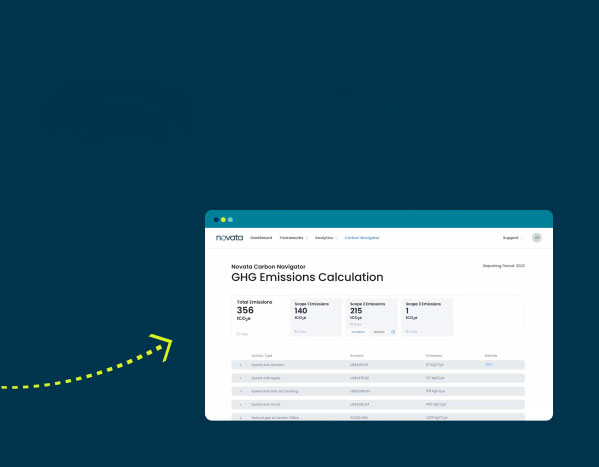Since our work began over a year ago, Novata has been focused on empowering private markets to achieve a more sustainable and inclusive form of capitalism. Building upon our core mission, we’ve developed the leading ESG data management platform to provide private market stakeholders with:
- clear frameworks for selecting and tracking key ESG metrics;
- a painless approach to data collection;
- a secure database for reporting and storing ESG performance data; and
- critical insights and analytic tools that inform investment decision making.
As we approach year-end, we are preparing to harness our mission and tools to report our non-financial material issues, goals, and performance. Further, in sharing our progress and process, we hope to provide a blueprint for how other organizations might approach their ESG tracking and reporting efforts. I recently caught up with John McArthur—senior fellow and director of the Brookings Institution’s Center for Sustainable Development and a member of Novata’s ESG Advisory Council – to help inform our work in this process. We focused primarily on the UN’s Sustainable Development Goals (SDGs), a collection of 17 goals which form a global priority list for dignity, peace, and prosperity for people and the planet, now and in the future.
When determining where to focus our efforts, we looked to the same global standards that informed the development of our ESG reporting platform. As a starting point, we pursued a double-materiality assessment aligned with the Global Reporting Initiative’s (GRI) guidance, considering issues that have both internal and external impact. After completing a SASB sector-specific materiality assessment, which determines the ESG issues most likely to impact Novata’s financial performance, we found that Data Privacy, Customer Privacy, Employee Engagement, and Diversity & Inclusion emerged as top priorities. From there, we shifted to evaluating Novata’s external impact, using the Sustainable Development Goals to align our practices with broader global sustainability efforts.
I sat down with John to discuss key questions on how to approach integrating SDGs into our reporting efforts, including how to determine targets and report progress.
Q: Given that we are a mission-driven ESG SaaS (Software as a Service) company, how should we be thinking about our own alignment to the Sustainable Development Goals?
JM: The word “alignment” is a great place to start. Any organization that wants to support the SDGs needs to consider alignment in both its external contributions and its internal operations. There are different types of SDGs too. For example, when we look across the 17 different Goals, I think of both Goal 17 (Partnerships) and, to a certain extent, Goal 9 (Industry, Innovation, and Infrastructure) as HOW goals that make the most sense when paired with other WHAT/outcome goals, like Goal 5 (Gender Equality) or Goal 13 (Climate Action). We need to think about partnership for Goal X or innovation for Goal Y.
Novata is a leader in building a “how” platform infrastructure—one that is partnership-driven, innovation-based, and industry-focused—which allows other companies to measure and advance alignment with their own objectives. One simple way of thinking about it is that Novata is contributing to Goals 9 and 17 in a manner that helps other companies align with other SDGs.
Another way to think about it is that Novata’s library of ESG metrics can help its clients’ portfolio companies, GPs, LPs, and other partners make progress on their own priority goals, which might link to a broad range of specific SDGs. For example, tracking employee health and safety relates directly to Goal 8 for decent work and economic growth. Fighting discrimination and promoting equal opportunity in the workplace and boardroom are central to Goal 5 for gender equality and Goal 10 for reducing inequality. Renewable energy use is part of Goal 7 for affordable and clean energy. Sustainable management and efficient use of natural resources is key to Goal 12 for responsible consumption and production. Avoiding bribery and corruption is pivotal to Goal 16 for peace, justice, and strong institutions. And on and on…!
These are all key business issues. They are also key societal issues. Together they underscore a deeper truth: if private markets don’t align with the SDGs, the world won’t achieve the SDGs.
Anything Novata offers to help corporations pursue SDG alignment throughout their ESG journey, whether using SDG jargon or not, is a contribution. Support can take many shapes on top of Novata’s core software product, ranging from publishing educational articles on key topics to hosting free events like webinars or convening workshops to share learnings around what works and what doesn’t in the private markets. Everything adds up.
Q: How should we be thinking about operative targets underlying our SDG priorities?
JM: When the 193 UN member governments agreed on all the official goals and targets, they definitely weren’t drafting every sentence with business users in mind. It can be easy—sometimes too easy—for organizations to declare themselves loosely aligned with one or more overarching SDGs. People often call this “SDG-washing.” Linking to a Goal’s more specific component area or operative target often adds clarity and specificity to the intent.
Since Novata’s core business could help so many different clients align their own metrics with different SDGs, I’d recommend a wide-aperture lens for looking at how Novata contributes to SDG targets. That said, in the spirit of drilling down on Goal 9 and Goal 17, Novata’s core business could help advance at least two specific targets:
- Target 9.4: By 2030, upgrade infrastructure and retrofit industries to make them sustainable, with increased resource-use efficiency and greater adoption of clean and environmentally sound technologies and industrial processes, with all countries taking action in accordance with their respective capabilities.
- Target 17.17: Encourage and promote effective public, public-private, and civil society partnerships, building on the experience and resourcing strategies of partnerships.
In looking across the other SDGs, a target under Goal 12 for responsible consumption and production also strikes me as highly relevant to Novata’s core purpose:
- Target 12.6: Encourage companies, especially large and transnational companies, to adopt sustainable practices and to integrate sustainability information into their reporting cycle.
Whichever targets Novata chooses to prioritize, I would encourage the company to engage a broad set of stakeholders in charting the course. For example, progress on Targets 9.4 and 12.6 implies interconnected efforts to upgrade current ESG data reporting and benchmarking methods and, over time, fundamentally change the infrastructure of ESG reporting in the private markets. If investors are consistently able to make investment decisions in a manner that improves overall alignment with the SDGs, this becomes a tremendous contribution. Similarly, Novata can make progress on Target 17.17 by continuing to deepen and build on partnership strategies with other organizations, like what it has been doing with Climate Neutral and Persefoni for Goal 13 (Climate Action) and the Women’s Awareness Initiative for Goal 5 (Gender Equality).
Q: How should we think about measuring progress towards these operative targets?
JM: Not all of the formal SDG targets are inherently measurable and assessable as written—as illustrated by some of the examples we discussed earlier—but they can still be benchmarked via an organization’s own metrics. For example, Novata could measure its progress on Targets 9.4 and 12.6 by tracking market adoption and client feedback on the usefulness of Novata’s platform in collecting and benchmarking ESG data. It can also make relevant data available for academic researchers to explore what motivates change among portfolio companies.
Target 17.17 might be tracked by measures such as big-picture process objectives for working with the best mix of stakeholder experts to refine metrics on the platform, or more micro-level indicators like data provider fill rates on metrics aligned with key SDG targets. In my view, there should be ample space for Novata and its users to experiment with metrics. Over time, both tracking progress against existing metrics and year-over-year refinement of metrics can be meaningful ingredients to inform success.
Q: Should we also report on the SDGs we’re aiming to be internally consistent with? For example, DEI programming in support of Goal 5 (Gender Equality) at Novata.
JM: Yes! As mentioned, pursuing internal alignment with the SDGs is a key piece of the puzzle. Organizations can track everything from how they are doing on workforce equity benchmarks to board composition and how their procurement and supply chains measure against social and environmental standards. These issues alone could map against more than half of the 17 SDGs.
The SDGs can also be a powerful tool for employee engagement. Beyond the intrinsic motivation that can come from knowing a company’s core product is contributing to the world’s SDG outcomes, staff members at all levels are likely to have great ideas on how an organization can take steps to align its internal operations with the SDGs. This can touch on anything from spotting opportunities to promote mental health in the workplace (target 3.4) to fostering social inclusion in group processes (target 10.2) and reducing food waste in the cafeteria (target 12.3).
The SDGs also offer a way for employees to connect and collaborate around shared interests outside of work, including in their local communities. Everyone has their own opinion on which SDG is “most important,” so the Goals offer a way for people to discuss and explore shared passions, which might range from fighting hunger (Goal 2) to promoting educational opportunities (Goal 4) or protecting local ecosystems (Goals 14 & 15).
These are surely only some of the different ways in which Novata, together with its clients and partners, can help advance the SDGs. As your question implies, it’s important not just to track where an organization is today, but also how it’s rolling out actions to do better tomorrow. Whenever Novata can share how it is aligning internally with SDG ambitions, it has the potential to become an important reference point for a much broader community focusing on ESG.
Thank you, John, for sharing your feedback on our process. We hope that by providing transparency on our journey, we can incentivize others to take the leap into reporting on their operations and non-financial performance.
Amanda Bangs is the Head of ESG Partnerships & Programs at Novata.






